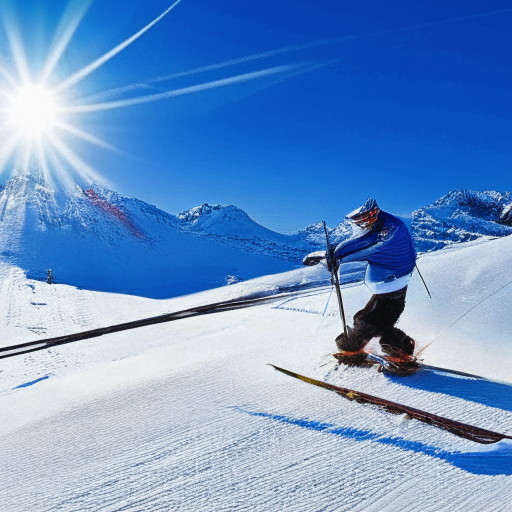Protect Your Vision: A Comprehensive Guide on Snow Blindness Prevention and Understanding
As the beautiful winter months envelop the earth in a blanket of snow, it’s imperative to be aware of the potential hazards that come with outdoor activities in such environments. One of the most pressing dangers is snow blindness, a temporary yet excruciating condition caused by prolonged exposure to ultraviolet (UV) rays that reflect off snow. This detailed blog post explores the intricate science behind snow blindness, investigates how sunlight bounces off snowy surfaces, and offers practical prevention methods, accurate diagnostic advice, and effective treatment options. By grasping the underlying causes of this affliction and implementing protective measures, we can relish the joys of winter while prioritizing our eye health.

Understanding the Medical Definition and Causes of Snow Blindness
The medical term for snow blindness is photokeratitis, which refers to a temporary injury to the cornea, the outermost protective layer of the eye. This painful condition primarily occurs due to excessive exposure to elevated levels of ultraviolet (UV) radiation, especially from rays that reflect off snow-covered landscapes. The bright sunlight, particularly at higher altitudes where the atmosphere is thinner, can lead to considerable discomfort and, in rare cases, long-term vision issues. While snow blindness often resolves on its own within a few days, comprehending its triggers is crucial for establishing effective prevention and management strategies that support lasting eye health.
Exploring How Sunlight Affects Snow and Your Eye Health
To fully understand the complexities of snow blindness, it is vital to investigate the interaction between sunlight and the snow’s surface. Sunlight travels through the atmosphere, encompassing a spectrum of wavelengths that includes harmful ultraviolet radiation. When these rays strike a snow-covered terrain, the unique reflective properties of snow can bounce back as much as 80% of these UV rays, significantly amplifying exposure levels. This reflection is even more pronounced in high-altitude regions where the atmosphere’s ability to filter harmful UV radiation is notably diminished. As a result, the eyes can quickly become inundated with excessive UV exposure, potentially causing damage to the cornea, conjunctiva, and other critical components of eye health.
Identifying Snow Blindness Symptoms for Quick Response
The signs of snow blindness usually start to appear several hours after exposure to intense UV light. While symptom severity can differ among individuals, common indicators include:
Eye discomfort and pain: Many people report a gritty feeling or the sensation of foreign particles in their eyes.
Redness and swelling: The eyes may look bloodshot, with swollen eyelids and noticeable inflammation.
Watery eyes: The body responds by producing tears to flush out irritants and alleviate discomfort.
Blurry vision: Activities that require sharp vision, such as reading or driving, can become challenging due to visual distortion.
Sensitivity to light: Increased light sensitivity, known as photophobia, often accompanies headaches and discomfort.
Sensation of halos: Some individuals may see bright rings or halos around light sources, contributing to visual confusion.
Proven Strategies to Safeguard Your Eyes Against Snow Blindness
When it comes to defending your eyes from the harmful effects of UV exposure, proactive measures are far more effective than seeking treatment after the fact. Here are several actionable tips to help you minimize the risk of snow blindness:
Select appropriate eyewear: Always opt for goggles or sunglasses that offer 100% UV protection when venturing into snowy environments. Look for eyewear labeled with UV400 or 100% UV protection for maximum safety.
Choose wraparound designs: Select sunglasses or goggles that wrap around the sides of your face to ensure comprehensive shielding against both direct sunlight and lateral UV exposure.
Utilize wide-brimmed hats: Hats with wide brims or neck flaps can provide extra shade, significantly diminishing UV exposure to your eyes.
Keep an eye on the UV Index: Before partaking in outdoor activities, check the local UV Index, which indicates daily UV exposure levels. Exercise caution and limit sun exposure during peak hours, typically from 10 AM to 4 PM.
Apply sunscreen thoughtfully: Although it may seem unrelated, applying sunscreen around your face and eyes can significantly lower UV exposure, enhancing your overall eye protection.
Take regular breaks inside: If you plan to spend extended periods in snowy environments, routinely take breaks indoors to give your eyes a chance to rest and recover from bright light exposure.
Effective Relief Strategies for Snow Blindness Symptoms
If you find yourself experiencing symptoms of snow blindness despite preventive measures, several strategies can help alleviate discomfort and promote recovery:
Seek shade immediately: Move to a darkened area or indoors to protect your eyes from further UV exposure.
Remove contact lenses: If you wear contact lenses, take them out to avoid additional irritation and facilitate proper recovery.
Apply cold compresses: Using a cold, damp cloth over closed eyes can effectively soothe discomfort and reduce swelling.
Use artificial tears: Over-the-counter artificial tears can provide temporary relief by keeping your eyes lubricated and easing dryness caused by snow blindness.
Avoid bright lights: Limit exposure to intense light sources, including screens and overhead lighting, to reduce the impact of photophobia during your recovery period.
Rest your eyes adequately: Engage in minimal visual strain activities, steering clear of reading or screen time to give your eyes the vital time they need to heal.
When to Seek Medical Assistance for Snow Blindness Symptoms
In most cases, the symptoms of snow blindness will start to diminish within 24 to 48 hours as the cornea begins to heal. However, it’s crucial to seek medical attention if symptoms worsen or persist, as delays in treatment could lead to complications or secondary infections.
Experiencing snow blindness can significantly detract from the enjoyment of winter activities, but with informed knowledge and precautionary measures, we can substantially reduce the risk while immersing ourselves in the breathtaking beauty of snowy landscapes. Stay vigilant about UV radiation levels, take regular breaks in shaded areas, and always prioritize wearing protective eyewear. If symptoms occur, seek relief promptly and consult a healthcare professional if necessary. By prioritizing eye safety, you can fully enjoy the winter wonderland and create lasting memories without sacrificing your vision. Embrace your adventures with caution!
The post Snow Blindness: Understanding Its Causes and Effects appeared first on Survival Bite.
The Article Snow Blindness Causes and Effects Explained Was Found On https://limitsofstrategy.com
The Article Snow Blindness: Understanding Its Causes and Effects First Appeared ON
: https://ad4sc.com

